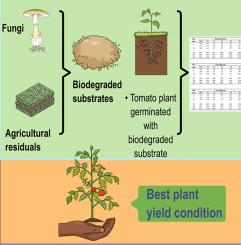对降解的 maguey pulquero 基质进行再资源化,促进茄果类植物发芽
IF 5.8
Q1 MICROBIOLOGY
引用次数: 0
摘要
龙舌兰(maguey pulquero)的蔗渣是在利用龙舌兰植物获取豆浆、菊粉、蜂蜜等过程中产生的残留物。由于其化学成分,它可用于培植龙舌兰属真菌,随后将降解材料 "降解基质(DS)"用作蔬菜发芽的支持物。这项研究的目的是描述由 Pleurotus djamor 生物降解的 maguey pulquero 甘蔗渣的特征,作为其价值链中的一个新视角,并随后用于番茄(Lycopersicon esculetum)的发芽。从 P. djamor 培养物中 60 天后回收了 DS,对其进行了理化鉴定,并通过扫描电子显微镜观察了植物组织的构象。DS 蛋白质(4.8%-3.3%)含量和纤维部分(54%-36%)有所下降,但干物质消化率从 47% 提高到 71%;此外,还观察到矿物质成分的变化,主要是钙浓度(6%)的变化。根据其成分,有可能在 L. esculetum 的发芽过程中重估 DS 的价值,以减少泥炭藓(商用泥炭)的使用。结果表明,可以使用 25% 的岩浆草 DS 与 75% 的泥炭藓混合(25:75),使发芽率达到 85%,出苗速度指数从 0.96 提高到 1.25。结论是可以实施一种循环战略,即利用龙舌兰甘蔗渣栽培蘑菇,然后回收废基质用于番茄发芽。本文章由计算机程序翻译,如有差异,请以英文原文为准。

Revalorization of degraded maguey pulquero substrate for Lycopersicon esculentum germination
The bagasse of Agave salmiana (maguey pulquero) is a residue generated during the exploitation of the plant to obtain pulque, inulin, honey, etc. Due to its chemical composition, it can be used for the cultivation of fungi of the Pleurotus genus and the subsequent use of the degraded material "degraded substrate (DS)" as a support for the germination of vegetables. The objective of the study was to characterize the bagasse of maguey pulquero biodegraded by Pleurotus djamor as a new perspective in its value chain, and subsequent use for the germination of Lycopersicon esculetum (tomato). The DS was recovered at 60 d from the P. djamor culture, characterized physicochemically and the conformation of the plant tissue was observed by scanning electron microscopy. The DS showed a decrease in protein (4.8–3.3 %) content and fibrous fraction (54–36 %), but dry matter digestibility increased from 47 to 71 %; in addition, changes in mineral composition were observed, mainly in calcium concentration (6 %). Due to its composition, it is possible to revalue DS in the germination of L. esculetum to reduce the use of peat moss (commercial peat). The results show that up to 25 % of maguey DS mixed with 75 % peat moss can be used (25:75), reaching a germination percentage of 85 % and increasing the seedling emergence speed index from 0.96 – 1.25. Concluding that it is possible to implement a circular strategy in which agave bagasse is used for mushroom cultivation and the subsequent recovery of the spent substrate for tomato germination.
求助全文
通过发布文献求助,成功后即可免费获取论文全文。
去求助
来源期刊

Current Research in Microbial Sciences
Immunology and Microbiology-Immunology and Microbiology (miscellaneous)
CiteScore
7.90
自引率
0.00%
发文量
81
审稿时长
66 days
 求助内容:
求助内容: 应助结果提醒方式:
应助结果提醒方式:


